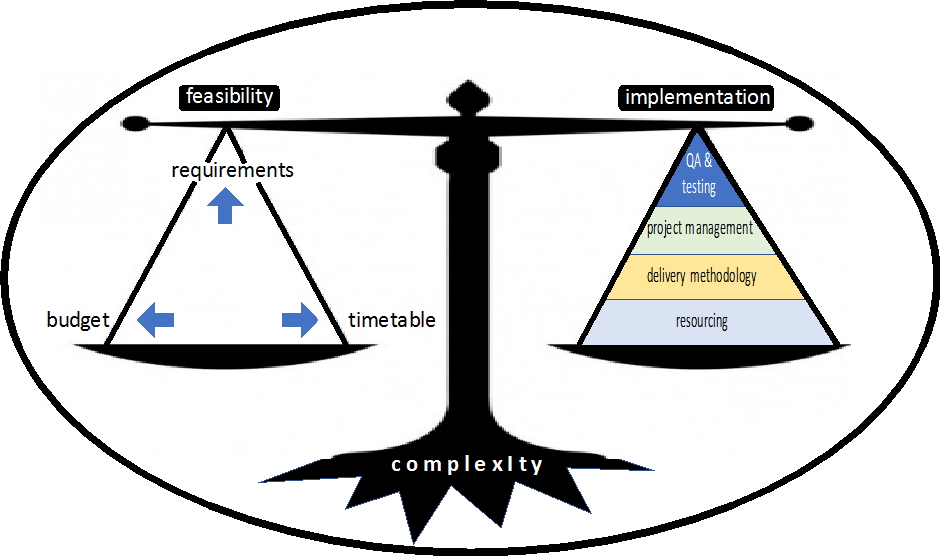Introduction
IT and digital transformation projects are complex, risky and prone to failure. That’s the key finding over 20 years in the US, UK and globally.[i] Seasoned leaders learned the hard way to avoid complex transformations, and became de-sensitised to the up-side risks of digital disruption. [ii] The covid economy is creating an unprecedented ‘burning platform’ that is accelerating the pace of digital transformation. Globally, business leaders are rushing to the fire. Beware. Necessity may be the mother of invention but it is a cruel ‘mother’ for those who aren’t prepared.
The main report identified multiple Critical Success Factors (CSFs). Each, done well, is critical to success; done badly, each is a notorious root cause of failure. Only four relate to classic implementation issues. It is a common misconception that, through innovative new methodologies like micro services, DevOps, Agile and cloud, these industry problems are history. On the contrary, no methodology is a silver bullet and, unfortunately, the industry has demonstrated a remarkable propensity to find new and more complicated ways to fail.
Implementing digital transformation: Four critical success factors (CSFs).
Expect digital transformation to pose complex implementation challenges. There are four implementation levers to get right. Each is critical to success. Managed badly, each can be a root cause of failure.
Resources: Mobilise the A-Team – those most comfortable with complexity, uncertainty, and risk. They have resilience, integrity, and trust. Competence, experience, leadership, and a one-team culture are key.
Delivery: You need a fit-for-purpose methodology that all parties understand and use properly over the entire scope and lifecycle. You do not need the latest digital methodology or architecture: they can become the source of additional and unfamiliar complexity.
Planning: You need a single-view-of-truth that is shared by all stakeholders and participants covering the project lifecycle, particularly key milestones, and critical success factors.
QA and testing: You need both delivery excellence and integrity. The testing function should be relatively autonomous with independent accountability (e.g., Group Risk or Assurance Director).
The Root Causes of Failure
Managed badly, these CSFs can each be a root cause of failure. Below are 10 of the most common root causes of complexity, risk and failure caused by inadequately managing your Critical Success Factors:
- Re-platforming core legacy systems.
- Heavy customisation of COTS or SaaS solutions.
- Lack of preparation (e.g., business case, technical feasibility study, options appraisal)
- Unstated, undocumented, or out-of-date requirements.
- ‘Big Bang’ go-live plan (vs a phased approach)
- Multi-dimensional transformation (e.g., infrastructure + applications + business processes)
- Over-reliance on new or ‘bleeding edge’ technologies, methodologies, or architectures.
- A ‘go live’ plan without the option to revert to the last viable instance
- A culture that encourages optimism bias and risk-taking, that discourages constructive challenge and tolerates chronic project and delivery failure.
- Business and deliver leadership lacking lack experience and expertise managing strategic IT change projects.
So, what is going on and what can be done? The Top 10 lessons for digital transformation success
- Complexity is the root cause of failure. It is highly predictive of project risk and failure – which is why so many seasoned leaders preferred to sweat their legacy IT for as long as possible. Today, complex digital transformations are unavoidable. It is time to understand the nature of digital transformation complexity, what causes it and how to deal with it.
- Project complexity is a function of feasibility and ‘implementability’. The project’s terms of reference define the feasibility challenge: delivery must find a way to implement it. Complex terms of reference require complex implementations. “Failure to implement” is a symptom. The real problem is usually the unfeasibly complex terms of reference.
- Complexity is self-inflicted. Failure doesn’t ‘just happen’ – although it can seem that way. It is caused by faulty strategic decisions to sign-off unfeasible terms of reference; which is why engaging senior stakeholders in governance is crucial.
- Feasibility is the triangulation of three Critical Success Factors – requirements, budget and timetable. They are found in the project’s charter or terms of reference. They interact in complex ways that are coldly indifferent to our ‘best laid plans’. Excessive requirements? Expect delays and cost over-runs. Unrealistic deadline? Expect unmet requirements and extra costs. Inadequate budget? Expect requirements and timetable to be compromised. Unrealistic terms of reference? Expect to fail.
- Complexity can be hard to spot – unless you know what to look for;[iii] and poor change control can render viable projects unfeasible.
- Unfeasible projects are unfixable (within their terms of reference). Tactical fixes and heroic efforts won’t work.
- All projects are fixable – but you may have to re-negotiate the terms of reference. Whether executives are willing to sign-off the cost, time and scope changes is another matter.
- Time is of the essence. The window for re-setting a failing project is limited; they burn through your money, time and options at an astonishing rate.
- Beware of optimism bias. Don’t re-frame your success criteria to accommodate failure. Don’t right-shift risk and complexity. Beware of the famous ‘dead cat bounce:’ failing projects can randomly ‘twitch’ looking like signs of recovery especially if you are desperate for good news.
- Have a Plan B. Don’t become dependent on the success of a strategic change project. No project is too important to fail. There are always alternatives. Be prepared to cut your losses.
Conclusion
Digital transformation is achievable if the Critical Success Factors are properly managed. If not, the notorious root causes of failure are lack of leadership, weak governance, overly ambitious requirements, inadequate budget, insufficient time, defective testing, poor planning, faulty methodology and inadequate resources.
Sources
[i] There are numerous studies around the world over the last 20 years verifying the point. The full report contains detailed references and recommended further reading. A 2019 survey of directors, CEOs, and senior executives found that digital transformation (DT) risk is their #1 concern. Yet 70% of all DT initiatives do not reach their goals. Of the $1.3 trillion that was spent on DT last year, it was estimated that $900 billion went to waste. Harvard Business Review, “Digital Transformation Is Not About Technology”, Tabriz , Lam , Girard and Irvin March 13, 2019.
[ii] An HBR/MIT survey of 1,000 CEOs (from 131 countries and 27 industries) shows that 90% of executives believe their businesses are being disrupted or reinvented by digital business models, and 70% believe they do not have the right skills, leader, or operating structure to adapt.“ Harvard Business Review, December 2016.
[iii] The full report provides detailed case studies and a typology of the most common examples of hidden complexity.
This paper is an executive summary of a larger investigation into why strategic IT and digital transformation projects fail, and what can be done to avoid it. It synthesises the findings of numerous public inquiries and research studies with the author’s first hand experiences working with global majors over more than two decades. It has benefited from extensive reviews and feedback from numerous industry experts, for which the author acknowledges his thanks.

Dr David Leabeater has designed, led and managed complex digital and business transformations as well as stepping in to rescue and renegotiate projects in crisis. He has 25 years of experience in senior leadership roles with HPE, CSC and AppLabs (all now DXC), Sopra Steria, Ernst & Young and Deloitte. Recently, he has been a board-level consultant on digital transformation projects, providing Quality Audits as well as advising on the re-design and renegotiation of problem projects. His investigations into “Why Digital Transformation Fails”… draws on over 25 years of first hand experiences and an extensive review of the major inquiries and research into both failing projects and industry best practices as well as feedback from industry leaders.
David now works and lives in the UK but was born in Australia and studied at the University of Sycney where he was awarded a doctorate in the philosophy of science.





